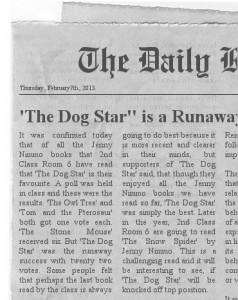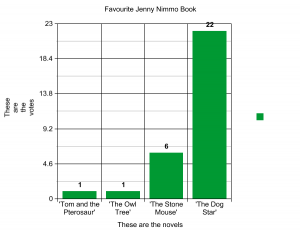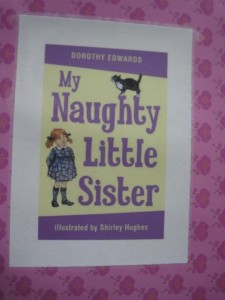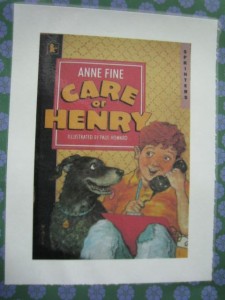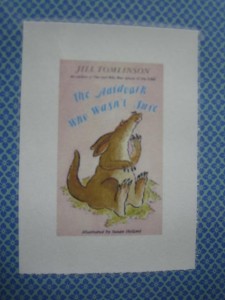
Photo ‘Quote 1’ by LDietrich528 on Flickr.
I think it would be useful if I gave you, the parent an overview of our plans for reading during this school year.
What we do in class might seem arbitrary and piecemeal to start with, but there is a plan for reading in place for the class.
At the beginning of 2nd class…
Many children are independent readers.
By the end of 2nd, I would like that all children would be reading independently and that they would develop a stamina for reading.
I hope that they get exposure to
a range of reading materials;
fact, fiction, stories, novels and poetry
know what they like to read
and love reading.
As J.K Rowling wrote:
“It is our choices, Harry,
that show what we truly are,
far more than our abilities.”
This plan stretches from September through to the end of June next year.
To maximize its success it is important that your child comes to school each day.
It is also important that you, the parent read with your child each night.
I know you all lead very busy lives and sometimes this may seem like a chore,
but it can be the most relaxing and pleasant time of the day for you and your child.
Memories are made of times when parent and child read together.
This plan is not written in stone.
Of necessity the plan for reading is flexible.
Every class is different and it may be that some classes are quicker to get to a certain point and others are slower.
But it isn’t a race. We are going to enjoy the journey.
Though it is a class plan, the focus is on your child as an individual.
This is like learning to walk.
This year I would like them to be ‘steadier’ readers i.e. more fluent
and to know what direction they would like to go
i.e. to know what are their preferences; know what they like to read.
Reading comprehension is also an important aspect of the work we will do this year.
The First Term
We will be ‘finding our feet’ at the beginning of the year.
During the first week the children will be bringing home books from the class library.
For the rest of the month they will be reading comprehension pieces from ‘A Way with Words’.
This reading will be in preparation for ‘follow up’ work in school.
I would suggest that you take a mental photograph of what this time is like;
the library books your child chooses to bring home
and your child’s level of fluency in reading these and the comprehension pieces.
Because later in the year your child will again be bringing ‘A Way with Words’ to read at home
and in the very last weeks of June,
your child will be bringing home class library books to read
and it will be heartening for you to see how they will have progressed.
Paired Reading
Then at the end of September, we will be doing six weeks of ‘paired reading’.
This will be for homework and I know most of you are familiar with ‘paired reading’ as the children have done this in previous years.
In school we will be working hard on the mechanics of reading e.g. the Dolch List, Jolly Grammar and Tricky Words.
Class Novels
I will also begin reading class novels to the children.
I have chosen these novels carefully and I have found that my past pupils have enjoyed these books.
This year I am adding a further Jenny Nimmo book ‘Tom and the Pterosaur’, which I am confident the children will like.
I also see great potential for developing comprehension skills using this and other novels.
From time to time during the year we will write Book Reviews.
We will also make comparisons between the books we have read: their similarities and differences
We will vote for our favourite book and our favourite author.
“You have to write the book that wants to be written.
And if the book will be too difficult for grown-ups,
then you write it for children.”
– Madeleine L’Engle
The Formal Reading Scheme
After ‘paired reading’ we will be starting the formal reading scheme.
This phase doesn’t go on indefinitely as has been necessary in Senior Infants and First.
It is a ‘Reading Blitz’. I estimate that it should take us another six weeks or more of intense work.
Term Two
This will bring us into the 2nd term and to the end of January approximately.
I am looking forward to this phase as it is where great strides forward can be made.
It is at this stage that we do some reading with ‘Reading Buddies’ (other children from the class).
The children really enjoy this. They find it companionable and sociable to read with a classmate.
The ‘Real Books’ Box
Children will progress at different rates. When the children have finished the formal reading scheme for 2nd class,
they will be reading from a box of books that I call ‘The ‘Real Books’ Box’.
These books and the notion of reading ‘real books’ acts like a ‘carrot on a stick’ I find and is very motivating.
Class Novels
After working hard on the reading scheme we can capitalize on all our hard work and start reading the class novels that are available to us
e.g. Jill Tomlinson’s ‘The Owl Who Was Afraid of the Dark’
and ‘The Owl Tree’ by Jenny Nimmo.
The Third Term
Class novels will occupy us for the rest of the year.
We are very fortunate. Because of the generosity of parents and the hard work of fund raisers we have a great variety of books to read.
You may be surprised that the class novels available to us as ‘multiple copies’ only contain two Roald Dahl books ‘Fantastic Mr. Fox’ and ‘George’s Marvellous Medicine’.
There is a reason behind this. We are only ‘dipping our toes in the water’ as far as the books of Roald Dahl is concerned.
If your child is taken with one or two of Dahl’s books in school, he or she will be very motivated to read some more independently from the school or local library or from their own bookshelf at home.
The School Library
Work on reading class novels will be supplemented by the children’s own choice of reading from the school library.
I will be helping the children to choose ‘readable’ and appropriate books.
Once again the children have an extensive choice of books to read from the school library thanks to the generosity of parents and the ‘Library Ladies’ who give so generously of their time.
In Summary:
So in a nutshell, reading for homework will be as follows:
*Children’s own choice of reading from class library.
*Paired Reading
*Formal Reading Scheme to include ‘Reading Buddies’
*Class Novels
*Children’s own choice of reading from class library.
*Children will also be bringing home reading from the school library.
Teacher Reading
from the ‘My Naughty Little Sister’ Series by Dorothy Edwards
‘Care of Henry’ and ‘Stranger Danger’ by Anne Fine
‘The Aardvark Who Wasn’t Sure’ by Jill Tomlinson
‘The Dog Star’ and ‘Tom and the Pterosaur’ by Jenny Nimmo
‘Please Mrs. Butler’ a compilation of school poems by Allan Alhberg
‘One Dark and Stormy Night’ Allan Alhberg
A selection of books from the school library to introduce the children to various authors and series.
Class Novels
A selection from the following:
‘Dog on a Broomstick’ by Jan Page
‘The Hodgeheg’ by Dick King Smith
‘The Owl Who Was Afraid of The Dark’ and ‘The Cat Who Wanted to Go Home’ by Jill Tomlinson
‘The Owl Tree,”The Stone Mouse’ and ‘The Snow Spider’ by Jenny Nimmo
‘Fantastic Mr. Fox’ and ‘George’s Marvellous Medicine’ by Roald Dahl
You can see more information about this selection of books on Our Bookshelf to the right 🙂
“You may have tangible wealth untold.
Caskets of jewels and coffers of gold.
Richer than I you can never be –
I had a parent who read to me.”
— adapted from Strickland Gillilan











